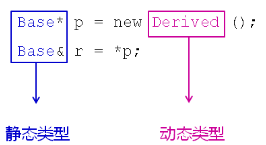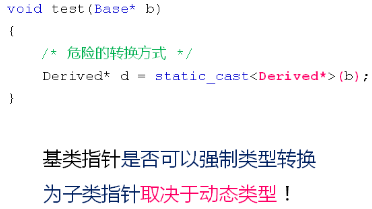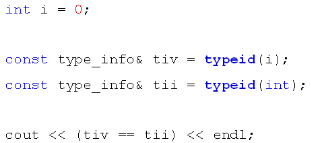0.目录
1.类型识别
2.动态类型识别
3.类型识别关键字
4.小结
1.类型识别
在面向对象中可能出现下面的情况:
- 基类指针指向子类对象
- 基类引用成为子类对象的别名

- 静态类型——变量(对象)自身的类型
- 动态类型——指针(引用)所指向对象的实际类型

2.动态类型识别
C++如何得到动态类型?
解决方案——利用多态:
- 在基类中定义虚函数返回具体的类型信息
- 所有的派生类都必须实现类型相关的虚函数
- 每个类中的类型虚函数都需要不同的实现
示例——利用多态动态类型识别:
#include <iostream>
using namespace std;
class Base
{
public:
virtual string type()
{
return "Base";
}
};
class Derived : public Base
{
public:
string type()
{
return "Derived";
}
void printf()
{
cout << "I'm a Derived." << endl;
}
};
class Child : public Base
{
public:
string type()
{
return "Child";
}
};
void test(Base* b)
{
/* 危险的转换方式 */
// Derived* d = static_cast<Derived*>(b);
if( b->type() == "Derived" )
{
Derived* d = static_cast<Derived*>(b);
d->printf();
}
// cout << dynamic_cast<Derived*>(b) << endl;
}
int main(int argc, char *argv[])
{
Base b;
Derived d;
Child c;
test(&b);
test(&d);
test(&c);
return 0;
}
运行结果为:
[root@bogon Desktop]# g++ test.cpp
[root@bogon Desktop]# ./a.out
I'm a Derived.
多态解决方案的缺陷:
- 必须从基类开始提供类型虚函数
- 所有的派生类都必须重写类型虚函数
- 每个派生类的类型名必须唯一
3.类型识别关键字
C++提供了typeid关键字用于获取类型信息:
- typeid关键字返回对应参数的类型信息
- typeid返回一个type_info类对象
- 当typeid的参数为NULL时将抛出异常
typeid关键字的使用:

typeid的注意事项:
- 当参数为类型时:返回静态类型信息
- 当参数为变量时:
- 不存在虚函数表——返回静态类型信息
- 存在虚函数表——返回动态类型信息
示例——typeid动态类型识别:
#include <iostream>
#include <typeinfo>
using namespace std;
class Base
{
public:
virtual ~Base() { }
};
class Derived : public Base
{
public:
void printf()
{
cout << "I'm a Derived." << endl;
}
};
void test(Base* b)
{
const type_info& tb = typeid(*b);
cout << tb.name() << endl;
}
int main(int argc, char *argv[])
{
int i = 0;
const type_info& tiv = typeid(i);
const type_info& tii = typeid(int);
cout << (tiv == tii) << endl;
Base b;
Derived d;
test(&b);
test(&d);
return 0;
}
运行结果为:
[root@bogon Desktop]# g++ test.cpp
[root@bogon Desktop]# ./a.out
1
4Base
7Derived
typeid在不同的编译器下行为不一样(也就是说打印出来的类型名是不一样的)。
4.小结
- C++中有静态类型和动态类型的概念
- 利用多态能够实现对象的动态类型识别
- typeid是专用于类型识别的关键字
- typeid能够返回对象的动态类型信息